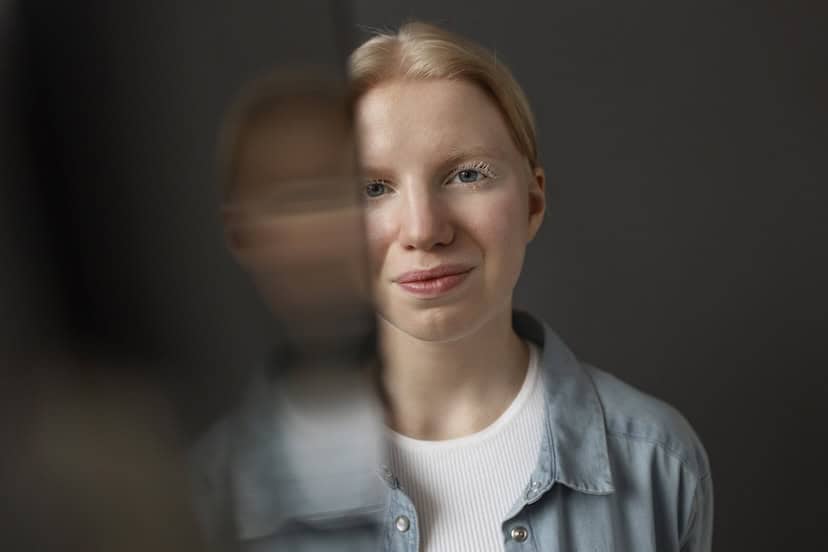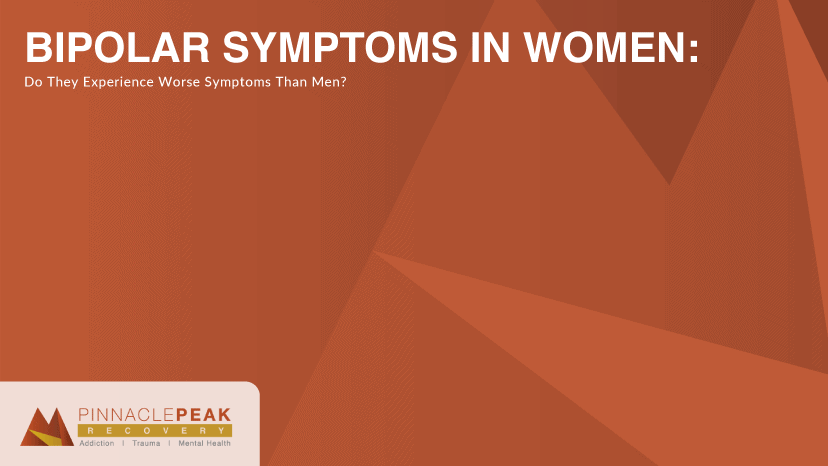The experience of being a woman comes with a lot of unique obstacles and milestones, from societal expectations to different health concerns. How does this translate to mental health conditions? Does bipolar disorder look different for men than women? Are bipolar symptoms in women specific to them?
Here in Arizona, nearly 260,000 adults have a serious mental health condition. That’s more people than the population of Scottsdale. Despite this, there’s still much to be understood about these mental health conditions. There is more research to be done and more education to spread to the community as a whole.
That’s our goal today. Our team here at Pinnacle Peak Recovery has seen how bipolar disorder can impact men and women alike. Our blog is going to talk about how bipolar disorder impacts women and how they experience it differently from men. With this knowledge, we hope more people will understand this condition and recognize when and how support can help those managing it.
How Does Bipolar Disorder Present in Women?
Bipolar disorder is a mental health condition that falls under the category of mood disorder. It most commonly develops during a person’s teenage years, but that doesn’t mean it is always diagnosed immediately.
There are more similarities than differences for men and women with bipolar disorder. Those with bipolar disorder experience periods of highs and lows, that last for days at a time. The symptoms associated with these periods, commonly referred to as episodes, can be intense with hospitalization sometimes being needed. The severity of their symptoms, the length of time they experience them, and how frequently they have episodes will determine what type of bipolar disorder they have.
Bipolar disorder is just as common in women as it is in men, but does it look different for one gender versus the other?
For women with bipolar disorder, it is very common that they are diagnosed with depression prior to receiving a bipolar diagnosis. In many cases, this depression diagnosis is erroneous, as their depressive symptoms weren’t stemming from a depressive disorder, but rather from bipolar disorder.
Additionally, the comorbidities of bipolar disorder frequently differ between men and women. Women are more likely to also have PTSD, anxiety disorders, and personality disorders alongside their bipolar disorder. Men with bipolar disorder, on the other hand, are more likely to have a substance use disorder or alcohol use disorder. This doesn’t mean that the opposite can’t be true for either gender, this is simply what happens most frequently.

Are the Causes of Bipolar Disorder Different for Women Than Men?
Our understanding of mental health conditions grows every day. In the past years, we’ve been able to better step away from viewing mental health conditions through cultural and societal lenses. For women in particular, this has been of great benefit, as many fields of medicine have overlooked how conditions specifically impact them over their male counterparts.
Despite years of research, finding the exact causes behind mental health conditions is still something we’re learning more about. There isn’t one specific cause that guarantees someone to have bipolar disorder, but there have been many factors noted that are often found in those with the condition.
The leading causes of bipolar disorder include genetics, family history, trauma, stress, brain injuries, and other mental health conditions. For women, this leads to an increased risk as women are more than twice as likely to experience trauma or develop PTSD than men.
At the end of the day, however, this doesn’t mean that significantly more women have bipolar disorder than men. On average across those with a bipolar disorder diagnosis, 52% of them will be women and 48% will be men.
How Does Pregnancy Impact Bipolar Disorder?
Pregnancy is a full-body experience. This means that not only does pregnancy cause physical changes, but it’s well known that it also causes mental ones.
Postpartum women are at a higher risk for severe mood changes and psychotic episodes. Postpartum depression, while the most commonly spoken of, is not the only thing women may experience after giving birth.
There is still much research being done specifically about bipolar disorder and the perinatal and postpartum periods of depression. Current studies show that women with bipolar disorder are at higher risk for experiencing postpartum psychosis. While there haven’t been specific studies regarding the risk of postpartum triggering episodes, or making episodes worse, it is known that stress can impact bipolar disorder. This means women who are pregnant, or recently gave birth, should be aware of the risks to their mental health.
Do Women Experience Different Types of Bipolar Disorder?
Bipolar disorder isn’t a singular condition, but rather a condition with different types that all fall under the same umbrella. These conditions vary in experience, and each have their own staple of symptoms and timelines.
The two primary types of symptoms that define bipolar disorder are manic symptoms and depressive symptoms. Manic symptoms are the “ups” in bipolar disorder, whereas the depressive symptoms are the “downs.”
Let’s take a closer look at the specific types of bipolar disorder, how they present, and how common they are in women.
Bipolar I Disorder
Bipolar I disorder is primarily classified by manic episodes that last at least seven days, with symptoms occurring most of the day, nearly every day. These symptoms can be severe enough to lead to hospitalization.
Those with Bipolar I often also experience depressive episodes, which tend to last closer to two weeks. They may also experience mixed episodes, which can involve any combination of depressive and manic symptoms.
It has been primarily believed that men are more likely to have Bipolar I than women. However, studies as recent as 2021 are starting to indicate that there is no significant gender difference in those diagnosed with Bipolar I. Research is still ongoing and it’s important to note that women can have Bipolar I, regardless of potential gender split in diagnosis.
Bipolar II Disorder
The primary symptoms experienced by those with Bipolar II are depressive episodes. They may also experience mixed episodes, or hypomanic episodes, which are less severe forms of manic episodes.
These depressive episodes can also lead to hospitalization in some cases, whether from lack of self-care or potentially from suicidal ideation and self-harm. Understanding the signs of depression can be very beneficial for those managing Bipolar II or living with someone who has Bipolar II.
This form of bipolar disorder is primarily associated with women. This is because women are more likely to experience depression than men. Generally, the difference is approximately 6% of women having a depressive disorder versus about 3.4% of men.
No matter the reason, the statistical difference has been noted. Men can still have Bipolar II, but it is more likely to be found in women.
Cyclothymic Disorder
Also known simply as cyclothymia, this form of bipolar disorder has a combination of both hypomanic and depressive symptoms. These symptoms, while reoccurring, are not intense enough nor last long enough to be classified as full episodes. There is no known gender difference in the diagnosis of cyclothymia.
How the Signs of Bipolar Disorder Differ for Women
We’ve touched on the categories of bipolar symptoms already, manic and depressive, but what exactly does this mean?
Manic symptoms are primarily associated with euphoria. This includes feeling like one has more energy than normal, being happier, and needing less sleep. These symptoms are not all innately positive. It can lead to reckless behaviors, too. Mania can cause increased agitation, snappiness, impulse decisions, and increased feelings of power.
Depressive symptoms are the opposite. Depressive symptoms make a person feel low energy, lonely, fatigued, and often lost. Increased feelings of worthlessness and decreased self-worth are regularly noted during depressive episodes. Things someone usually enjoys become of little interest, and an increase in thoughts of self-harm and suicidal ideation can occur.
Why Do Women Experience More Depressive Symptoms Than Men?
The specific cause of this hasn’t been pinned down, but many theories prevail. Some point to hormonal changes, with women aged 14-25 being twice as likely as men of a similar age to have depression. Others point to societal standards and cultural differences in how women are expected to behave, react to relationships, manage their emotions, and more.
More research still needs to be done to reach a conclusion and better understand the source of this, but the differences have been noted and should be kept in mind.
Alcohol-Withdrawal Only
- Depression
- Mood swings
- Headaches
- Fever
- Fatigue
- Seizures
Both Alcohol-Withdrawal & Anxiety
- Trouble thinking
- Nausea
- Rapid heart rate
- Irritability
- Increased sweating
- Shakiness

Finding the Right Treatment for Women with Bipolar Disorder in Arizona
Seeking treatment for your mental health can seem scary. How can you be certain you find a place that understands? You may even be dealing with feelings of doubt about whether you even need or deserve to seek treatment.
We’re here to tell you that, no matter your gender or history of mental health, you deserve access to support and care. There’s no threshold that makes you eligible or worthy of bipolar disorder treatment.
There are teams that will approach your care plan with compassion, offering a variety of evidence-based options so you can find the right treatment for you. That team is here at Pinnacle Peak Recovery. To get started on your healing journey, with long-term support and care, just give us a call at 866-377-4761.
Clinical Excellence | Compassionate Care | Family Feel
FAQ About Symptoms of Bipolar Disorder in Women
What age does bipolar start in women?
Bipolar disorder most commonly develops during the teenage years, but this doesn’t mean that it is always diagnosed during that time. It can also be triggered later in life due to high stress or trauma.

